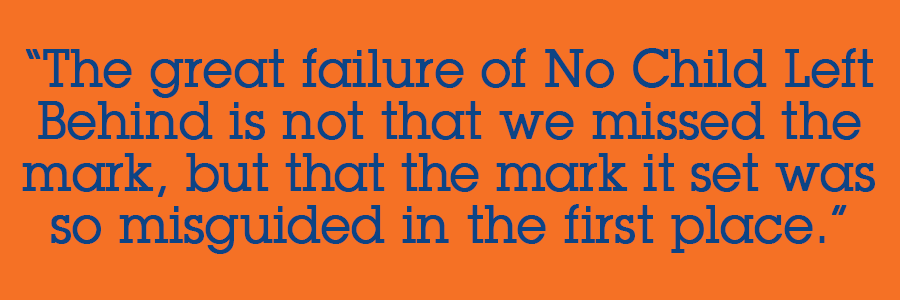What does the year 2014 matter in the history of public education? For those who are keeping score, this is the year, according to the No Child Left Behind Act (NCLB), when every student in America was supposed to have achieved proficiency. According to the law, which was passed with much fanfare in 2001, in order for every child to reach his or her potential, math and literacy scores were expected (mandated, really) to increase for every student in every school until 100 percent had passed the requisite tests in the fateful year of 2014.
NCLB has brought needed attention to equity in education and more scrutiny to failing public schools. But in the meantime, we have missed the mark NCLB set thirteen years ago, and missed it by a long shot. The great failure of the legislation is not that we missed the mark but that the mark it set was so misguided in the first place. If New York;s new chancellor is to seize the moment of a new era in education, we need to start by recognizing three failings of the accountability system that NCLB created and figure out how to address them.
First of all, the mark set by NCLB assumed that every child’s potential must be measured in math and literacy. Are these critical skills? Of course they are. Are they all that matter? Of course they are not. The very notion that we can reduce all of learning to the linear growth of two skills is tantamount to measuring someone’s health entirely by their blood pressure. NCLB succeeded in helping everyone recognize that students cannot succeed if they cannot read or do basic math; it failed by imagining that there is nothing more to life than reading and math.
Second, the mark assumed that test scores administered once a year are the best gauge of such achievement. Has any genuine research ever supported the idea that a single annual assessment is sufficient to score individual growth? No. Such tests are valuable when measuring student growth in the aggregate—across hundreds or thousands of students—but the volatility in results and their inability to adapt to differences among students negate their value in the individual level. Billions spent on collecting standardized test scores have successfully given us a sense of how students perform across school districts and states (the answer: not very well), but they do little to tell us meaningfully about how individual students are doing.
Third, the mark assumed that schools exist to help every child reach his or her potential. This noble goal is perhaps the hardest part to quibble with in the law. But individual potential is in fact only half the story. Schools in a democracy exist not only to help the individual but also to help the community reach its potential, and to do this our children must be instilled with a commitment to the betterment of others, not only themselves. While this may seem a semantic difference at first, we have seen the way the earnest and well-intentioned commitment to the individual has skewed our accountability systems in schools. Little to no official recognition is given to the school as a community or the student as a member of society; all is focused on the aggregation of individual achievement.
As Mayor de Blasio and Chancellor Fariña consider how they can improve education at this pivotal moment in New York City, they have the opportunity to address these three failures in a new accountability system.
First: The failure to recognize the diversity of learning. While we can and must work hard to develop students’ literacy and math, an accountability system that focuses exclusively on these fails to realize the rich and diverse lives that our schools can cultivate in our youth through the arts and science, through collaboration and independence, through design and discovery, through problem solving and meaning making. An accountability system that takes this into account will not aim to generate simple numeric scores that are expected to increase from 1 to 200 (as NCLB did) but will instead offer measures and interpretation of measures that reflect and refract the multiple possibilities of learning.
Second: We must address the failure to recognize the diversity of assessments. While summative standardized tests can be useful on occasion, we must not confuse their precision (that is, the fact that they yield exact numeric results) with their accuracy (that is, whether they give us numbers that are meaningful). The multiple assessments that teachers use every day in their classrooms as well as the authentic assessments that occur when students practice real-life skills for real-life audiences provide a multiplicity of perspectives that give a deeper and richer picture of growth.
Third: We must address the failure to recognize the twofold purpose of education. While we want every child to be able to reach his or her potential, we are actually making ourselves and our society worse if we do not also want every child to help others reach theirs. College and career are insufficient without character and community. An accountability system that recognizes this will not only aggregate the progress of individual students but also gauge the way in which the school as a whole and the collaborative groups within it contribute to and connect with the larger community.
Thirteen years ago, NCLB dreamed that we could ask every student to enter kindergarten and climb the ladder to success by their senior year of high school. This dream of equity is worthy, but the ladder it hands us to get there is not. A new era gives us the chance to learn anew that education is about so much more than climbing the rungs of a ladder. Let’s seize the moment and create an accountability system that recognizes that.


Trackbacks/Pingbacks